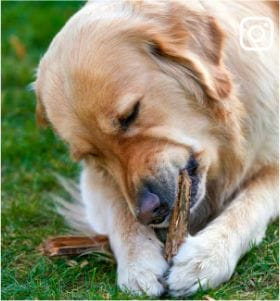Page Not Found!


Why Dogs Love to Chew: The Natural Instincts Behind Your Dog’s Favorite Habit
Welcome to the fascinating world of canine behavior! This topic delves into the intriguing question of why dogs have a natural affinity for chewing. Understanding this behavior is crucial for all dog owners, as it sheds light on the innate instincts that drive our furry companions. From puppies exploring the world to adult dogs relieving stress, chewing plays a significant role in a dog's life. By uncovering the reasons behind this behavior, we gain valuable insights into our dogs' needs and preferences. Join us on a journey to unravel the mysteries behind why dogs love to chew, and discover how this simple habit is deeply rooted in their nature.
The Innate Drive to Chew

Dogs have a natural instinct to chew, a behavior that dates back to their ancestors who needed to chew on bones and tough materials to survive. This behavior not only helped in keeping their teeth clean and strong but also satisfied their innate urge to chew. Even today, chewing plays a vital role in a dog's life, offering mental stimulation, stress relief, alleviating boredom, and maintaining dental health by reducing plaque and tartar buildup. Selecting appropriate chew toys and treats is essential to cater to dogs' natural instincts and ensure their overall well-being.
The act of chewing is deeply ingrained in a dog's DNA. It serves various purposes beyond just satisfying a craving. When a dog chews, it releases endorphins, which are hormones that promote a sense of calmness and well-being. This explains why dogs often turn to chewing when they are anxious or bored. By providing them with suitable chew items, you can help your furry friend manage stress and stay mentally engaged.
Furthermore, chewing is a natural way for dogs to explore their surroundings and relieve pent-up energy. It's a form of self-soothing for them, akin to how humans might engage in stress-relieving activities. Engaging in appropriate chewing behavior can prevent destructive habits like excessive barking or digging, as it redirects their focus onto a positive outlet.
In terms of dental health, chewing on textured toys and treats can help massage gums, scrape away plaque, and reduce tartar buildup. This not only keeps their teeth clean but also contributes to fresher breath and overall oral hygiene. Regular chewing can also strengthen jaw muscles and improve saliva production, which aids in digestion.
When selecting chew toys for your dog, consider their size, age, and chewing habits. For strong chewers, opt for durable toys made of rubber or nylon that can withstand heavy chewing. Puzzle toys or treats that require some effort to extract can provide mental stimulation and prevent boredom. Always supervise your dog when introducing a new chew item to ensure they interact with it safely.
Chewing for Well-being

Chewing is not just a simple act of breaking down food; it can significantly impact our overall well-being. In this blog section, we will explore the various aspects of chewing that contribute to our health and happiness.
Dental Health Benefits of Chewing
Chewing is not only essential for digesting food but also plays a crucial role in maintaining good dental health. When we chew, our salivary glands are stimulated to produce saliva, which helps in neutralizing acids in the mouth, thus reducing the risk of tooth decay. Additionally, the act of chewing exercises the jaw muscles, promoting jawbone strength and overall oral health.
Stress Relief and Anxiety Management through Chewing
Chewing gum or food is not just beneficial for our physical health but also for our mental well-being. Studies have shown that chewing can help in reducing stress and anxiety levels by lowering the release of cortisol, known as the stress hormone, in the body. The rhythmic motion of chewing can have a calming effect on the mind, providing a simple yet effective way to manage daily stressors and promote emotional balance.
Cognitive Benefits of Chewing
Apart from its physical and emotional advantages, chewing also offers cognitive benefits. Chewing has been linked to improved cognitive function, memory retention, and alertness. The increased blood flow to the brain during chewing can enhance mental clarity and focus, making it a valuable tool for boosting productivity and concentration.
Chewing for Weight Management
Incorporating mindful chewing habits can aid in weight management. Chewing slowly and thoroughly allows the brain to receive signals of fullness, preventing overeating and promoting better digestion. By savoring each bite and being present during meals, individuals can cultivate a healthier relationship with food and make more conscious dietary choices.
Cultural and Social Significance of Chewing
Chewing holds cultural significance in many societies around the world. From traditional chewing rituals to modern-day practices, the act of chewing has been intertwined with social gatherings, ceremonies, and celebrations. Exploring the cultural aspects of chewing can provide insights into its symbolic meanings and societal importance.
Addressing Destructive Chewing

Dogs are known for their love of chewing, but when this behavior becomes destructive, it can be frustrating for pet owners. In this section, we will explore how to recognize problematic chewing behaviors in dogs and discuss effective strategies for correction.
Chewing is a natural behavior for dogs that helps with dental health and alleviates boredom. However, destructive chewing, such as gnawing on furniture, shoes, or other inappropriate items, can be a sign of underlying issues. It's essential for pet owners to differentiate between normal and problematic chewing behaviors.
Recognizing Problematic Chewing Behaviors:
Excessive chewing on non-toy items
Aggressive or intense chewing
Chewing in specific locations
Anxiety-related chewing
Understanding these signs can help identify if your dog's chewing behavior is becoming problematic. Once identified, it's crucial to address the issue to prevent further damage and ensure your pet's well-being.
Effective Strategies for Correction:
Provide appropriate chew toys and rotate them regularly to keep your dog engaged.
Use deterrent sprays on items your dog tends to chew inappropriately.
Increase physical and mental stimulation through regular exercise and interactive play.
Consider crate training to manage chewing behavior when unsupervised.
Seek professional help from a veterinarian or animal behaviorist for severe cases.
Additional Information:
Understanding the Root Cause: Identifying the root cause of destructive chewing is crucial. It could stem from separation anxiety, lack of exercise, teething in puppies, or even nutritional deficiencies. By pinpointing the underlying reason, you can tailor your corrective strategies more effectively.
Positive Reinforcement: Utilize positive reinforcement techniques when your dog chews on appropriate items. Praise and reward good behavior to reinforce the desired actions, encouraging your pet to choose the right chewing options.
Consistency is Key: Consistency in training and correction is vital. Establish clear rules and boundaries for chewing behavior and ensure all family members follow them to provide a unified approach.
Regular Check-ups: Regular veterinary check-ups can help rule out any medical conditions that may contribute to excessive chewing. Your vet can also provide guidance on managing your dog's oral health, which can impact their chewing habits.
Guiding Healthy Chewing Habits

Ensuring that your furry friend maintains healthy chewing habits is crucial for their overall well-being. When it comes to selecting chews and toys for your pet, it's essential to consider various factors to promote good oral hygiene and prevent destructive behavior. Factors such as your dog's size, breed, and individual chewing tendencies all play a significant role in determining the most appropriate chews.
Choosing the right chews is vital. Opt for natural options with textured surfaces as they not only offer a more engaging chewing experience but also aid in maintaining dental health.
Look for chews made from durable materials to withstand your dog's chewing strength and ensure they are safe for consumption.
Natural ingredients are key to avoiding harmful additives that could potentially harm your pet's health.
Introducing new chews gradually is a fundamental step in helping your pet adjust and form a positive association with the items. By closely monitoring their reactions, you can understand their preferences and make informed decisions on which chews best suit your dog's needs. Regularly rotating and replacing chews is crucial to prevent boredom and encourage sustained interest in chewing, thus reducing the likelihood of developing destructive behaviors.
Supervision during chewing sessions is vital, especially when introducing new chews. This allows you to redirect any inappropriate chewing behavior and ensure your pet's safety. Participating actively in your dog's chewing activities not only strengthens the bond between you and your pet but also offers an opportunity to reinforce positive chewing habits.
Prioritizing your pet's mental and dental health through suitable chews and toys not only promotes good oral hygiene but also contributes to their overall well-being. Regular dental check-ups are recommended to complement the benefits of chewing on dental health. Remember, a healthy chew is a happy chew!.
Training for Positive Chewing

Training your beloved pet for positive chewing habits is a crucial aspect of responsible pet ownership. By laying a strong foundation of patience and consistency, you can instill good chewing behaviors in your furry friend, leading to a harmonious coexistence. Let's delve deeper into effective methods that can aid in fostering these habits.
Methods to Encourage Good Chewing Habits
Selecting the Right Chew Toys: Opt for a variety of chew toys that are suitable for your pet's breed and size. Different textures and materials can help satisfy your pet's chewing needs and prevent boredom.
Positive Reinforcement Techniques: When your pet engages with their chew toys appropriately, shower them with praise and rewards. Positive reinforcement not only encourages the desired behavior but also strengthens the bond between you and your pet.
Supervision and Redirection Strategy: During the initial training phase, closely monitor your pet's chewing activities. If you catch them chewing on inappropriate items, calmly redirect their focus to the designated chew toys. Consistent redirection helps in establishing boundaries.
Additional Methods to Encourage Good Chewing Habits
Rotating Chew Toys: Introduce new chew toys periodically to keep your pet engaged and prevent monotony. Rotating toys also helps in maintaining your pet's interest and reduces the likelihood of them resorting to furniture or other items.
Incorporating Dental Chews: Dental chews not only provide a chewing outlet but also contribute to your pet's dental health. These specialized chews can help in reducing plaque and tartar buildup, promoting overall oral hygiene.
Consistency and Patience in Training
Reinforcing Consistent Corrections: It's vital to consistently correct your pet whenever they indulge in undesirable chewing behavior. By providing immediate corrections each time, your pet will gradually understand what is acceptable to chew.
Steer Clear of Punitive Measures: Avoid resorting to punishment-based training techniques as they can instill fear and anxiety in your pet. Positive reinforcement, on the other hand, promotes a positive learning environment and yields better long-term results.
Embrace Patience Throughout the Process: Remember, training is a gradual journey, and each pet learns at their own pace. Stay patient, persistent, and maintain a positive attitude to witness sustainable improvements in your pet's chewing habits.
The Benefits of Positive Chewing Habits
Developing good chewing habits in your pet not only protects your belongings but also benefits your pet's mental and physical well-being. Proper chewing helps in relieving stress, keeping teeth clean, and preventing destructive behavior born out of boredom.
Conclusion
Understanding the natural instincts behind why dogs love to chew is essential for all dog owners. By recognizing that chewing is a natural behavior rooted in their genetics, we can provide our furry friends with appropriate outlets for this instinct, such as chew toys and treats. Embracing and accommodating this behavior not only keeps our dogs happy and engaged but also strengthens our bond with them. So, next time you see your dog happily gnawing on a toy, remember that it's their way of expressing their natural instincts, and embrace it with love and understanding.
FAQs
Q: Why do dogs chew?
A: Chewing is a natural instinct that helps dogs relieve stress, clean their teeth, and explore their environment.
Q: Is chewing harmful to my dog's teeth?
A: Chewing on appropriate chew toys can actually help clean teeth and prevent plaque buildup.
Q: How can I choose the right chew toy for my dog?
A: Consider your dog's size, age, and chewing style when selecting a chew toy.
Q: Are rawhide chews safe for dogs?
A: Rawhide chews can pose choking and digestive risks. It's best to opt for safer alternatives.
Q: Can excessive chewing damage my dog's teeth?
A: Yes, excessive chewing on hard objects can damage teeth and gums.
FOLLOW FELLOW DOGGIES ONLINE @DOGCHITS









